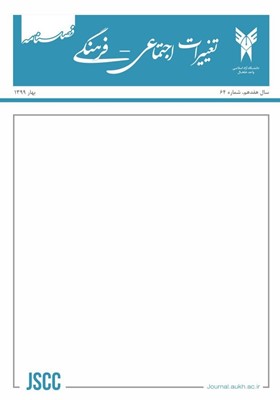فراتحلیل گرایش جامعه ایرانی به مدیریت بدن
محورهای موضوعی : خانواده
طاهره جهان پرور
1
![]() ,
طاها عشایری
2
*
,
طاها عشایری
2
*
1 - دانشجوی دکتری جامعه شناسی فرهنگی، واحد تهران مرکزی، دانشگاه آزاد اسلامی، تهران، ایران
2 - استادیار گروه تاریخ و جامعه شناسی، دانشکده علوم اجتماعی، دانشگاه محقق اردبیلی، اردبیل، ایران.
کلید واژه: فراتحلیل, مدیریت بدن, تمایزطلبی, فشار هنجاری, منابع رسانه,
چکیده مقاله :
بدن مقوله اجتماعی و امری زیستی-فرهنگی است متناسب با فرهنگ و هنجار جامعه، بدن نیز تغییر مییابد، در جهان امروز، بدن به امری مهم در روابط اجتماعی، سلامت اجتماعی و سبک زندگی نشاط محور بدل شده است و همچنین کسب منزلت اجتماعی و تأیید اجتماعی، بدن را بیشتر محور توجه جامعه قرار داده است، پژوهش فعلی با استفاده از روش فراتحلیل در پی بررسی دلایل گرایش جامعه ایرانی به مدیریت بدن است. جامعه آماری آن 68 سند که 39 تحقیق به روش تعمدی-قضاوتی در بازه زمانی 1387 الی 1400 انتخاب شدند. یافتهها در بخش توصیفی نشان میدهد که سال 1392، بیشترین مطالعه (23 درصد) در این بازه زمانی صورت گرفته و در شهر تهران (23 درصد) اجر شده است. خانمها عمدتاً (69 درصد) هدف مطالعه بوده و روش تحقیق از نوع خوشهای (41 درصد)، بوده است. میزان گرایش به تغییرات در بدن (مدیریت بدن) در سطح بالا (35 درصد)، متوسط (29 درصد) و پایین (36 درصد) است. اندازه اثر مطالعات از 39 تحقیق، حاکی از این است که منابع رسانه، سرمایه فرهنگی، سرمایه اجتماعی، سرمایه، منابع ساختاری، سبک مصرفی، عوامل روانی، تمایزیابی، جامعهپذیری و عوامل زمینهای در گرایش ایرانیان به مدیریت بدن تأثیر معناداری دارد.
The body is a social category and a bio-cultural thing. In proportion to the culture and norm of society, the body also changes. In today's world, the body has become an important thing in social relations, social health and a cheerful lifestyle, as well as gaining social status and approval. Social, the body has become more the focus of society, the current study using meta-analysis method seeks to investigate the reasons for the tendency of Iranian society to manage the body. The statistical population is 68 documents, of which 39 researches were selected by deliberate-judgmental method in the period of 1387 to 1400. Findings in the descriptive section show that in 1392, the most study (23%) was done in this period and was performed in Tehran (23%). Women were the main target of the study (69%) and the research method was cluster type (41%). The tendency to change in the body (body management) is high (35%), medium (29%) and low (36%). The effect size of studies from 39 studies indicates that media resources, cultural capital, social capital, capital, structural resources, consumption style, psychological factors, differentiation, socialization and underlying factors have a significant effect on Iranians' tendency to manage the body.
_||_

